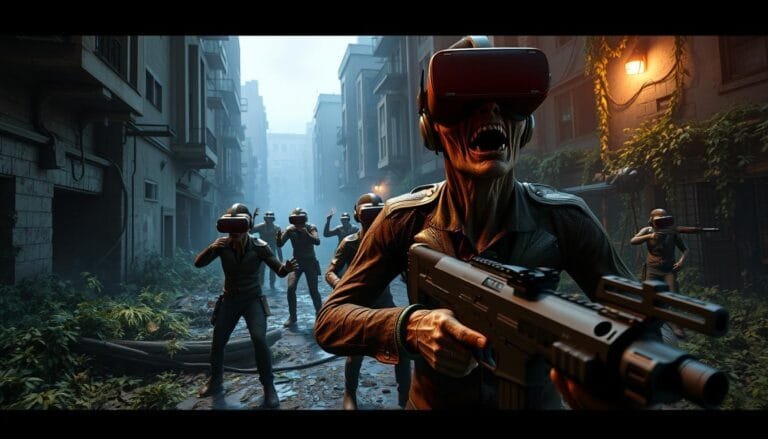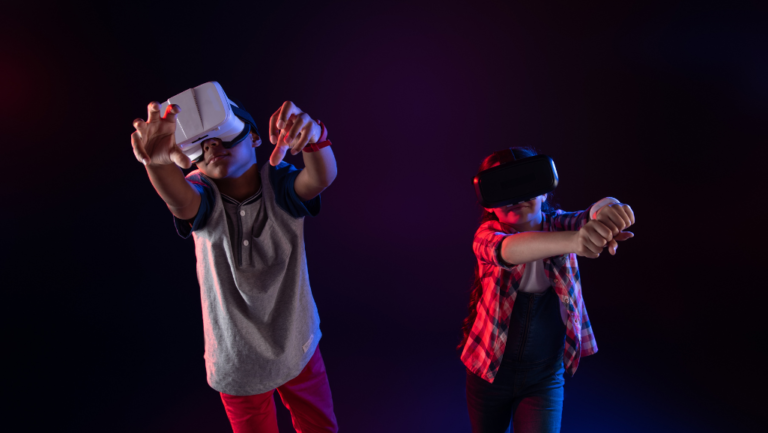Get ready for a thrilling ride in interactive horror games. These games throw you into scary worlds where you must survive. From classic survival horror to psychological thrillers, the genre keeps evolving and drawing in gamers everywhere.
Interactive horror games are known for their intense gameplay and stories that change based on your choices. You have to make quick decisions that affect the story and the characters’ lives. Whether it’s managing resources in Resident Evil or making choices that impact your party, every action matters.
The horror genre is back in a big way, with indie games exploring new fears and AAA titles perfecting the scare. Psychological horror games dive deep into the human mind, making it hard to tell what’s real and what’s a dream. Multiplayer horror games bring a new level of fear, requiring teamwork and communication to stay alive.
Key Takeaways
- Interactive horror games offer immersive experiences with branching narratives and impactful player choices.
- The genre encompasses a wide range of styles, from survival horror to psychological thrillers.
- Indie horror games often deliver unique and boundary-pushing scares.
- Multiplayer horror games add a new level of intensity, requiring teamwork to survive.
- Recent years have seen a resurgence in the horror genre, with both AAA and indie titles captivating players.
Introduction to Interactive Horror Games
Interactive horror games have been thrilling players for decades. They offer a unique and immersive experience. These games aim to create a terrifying atmosphere that keeps players on the edge of their seats.
They use heart-pounding jump scares and eerie environments. These elements leave a lasting impression on players.
Defining Features of Interactive Horror Games
One key feature is the emphasis on atmospheric horror. Developers craft unsettling environments. They use sound design, lighting, and visual effects to create a sense of dread.
Games like Silent Hill and Amnesia: The Dark Descent excel in this. They create a deeply immersive and terrifying atmosphere.
Another important aspect is unique horror gameplay mechanics. These mechanics make players feel vulnerable and helpless. They add to the overall fear factor.
Games like Outlast and Alien: Isolation feature mechanics like hiding from enemies. They also include managing limited resources and solving puzzles under intense pressure. These elements contribute to a heart-pounding experience.
Trends in Interactive Horror Gaming
In recent years, the horror gaming genre has seen a surge in popularity. Developers are experimenting with new trends and innovations. One notable trend is the rise of narrative-driven horror experiences.
Games like Until Dawn and The Dark Pictures Anthology series focus on storytelling. They emphasize character development and player choice. This allows for a more personalized and engaging horror experience.
“Horror games have the unique ability to immerse players in a way that no other genre can, tapping into our deepest fears and creating unforgettable experiences.”
Another popular trend is the incorporation of multiplayer elements. Games like Dead by Daylight and Phasmophobia allow players to experience horror together. They can play as survivors trying to escape a killer or as paranormal investigators exploring haunted locations.
These multiplayer horror games have a dedicated following. They are popular choices for streaming and online communities.
Top Interactive Horror Games to Play
Horror game fans love the thrill of interactive horror games. These games have many endings and story paths. Your choices can change the story and characters’ fates. Interactive horror games have grown more immersive and scary over time.
Notable Titles from 2022 and 2023
Recent years have seen many interactive horror games. “Signalis” (2022) mixes old-school looks with a creepy vibe. “The Quarry” (2022) and “MADiSON” (2023) let you decide the story. “Resident Evil 4” remake (2023) is expected to bring a new twist to a classic.
Classic Games That Set the Standard
Classic horror games are key to the genre. “Silent Hill” (1999) and “Silent Hill 2” (2001) are known for their deep horror and choices. “Amnesia: The Dark Descent” (2010) and “Outlast” (2013) started the first-person horror trend. “Until Dawn” (2015) is famous for its choice-driven gameplay.
“Interactive horror games have the power to immerse players in terrifying worlds where every choice matters, creating a truly personal and unforgettable experience.”
Indie Gems Worth Exploring
Indie games have also made a big impact. “Phasmophobia” (2020) is loved for its ghost hunting. “Visage” (2020) is creepy and explores a haunted house. “Inscription” (2021) mixes cards with mystery. VR technology has brought new scares, like in “Resident Evil 7: Biohazard” (2017) and “The Walking Dead: Saints & Sinners” (2020).
If you love classic horror, story-driven games, or indie titles, there’s plenty to play. So, turn off the lights, put on your headphones, and get ready for these chilling adventures.
The Evolution of Horror in Gaming
Horror games have evolved a lot from the 1980s. Early games like Sweet Home and Splatterhouse started it all. Then, Resident Evil and Silent Hill took it to new heights, making players feel scared.
With better technology, horror games got scarier. Games like Amnesia: The Dark Descent and Outlast focused on atmosphere and tension. They didn’t need jump scares to scare you.
Now, games like The Last of Us focus on stories and characters. This makes the horror even more intense.
Virtual reality technology has changed horror games a lot. VR lets players feel like they’re right in the game. Games like Resident Evil 7: Biohazard and P.T. show how VR can make games scary.
“Horror games have always been about pushing boundaries and creating unique experiences that stay with players long after they’ve finished playing.” – Shinji Mikami, creator of Resident Evil
Horror games now come in many styles. You can find survival horror, psychological horror, and supernatural horror. Indie games like Little Nightmares and Doki Doki Literature Club! also add new ideas to the genre.
The Future of Horror Gaming
The future of horror games looks exciting. New VR tech, like the Meta Quest 3, will bring even more realism. Developers are trying new things, like the Nope Challenge, which tests players for phobias.
Games like Dead By Daylight show how important community is. They keep players interested with new content. Fans help add to the game’s story, making it more fun for everyone.
Mechanics of Fear: How Interactive Horror Games Engage Players
Interactive horror games are experts at making players feel fear. They use psychological tricks to make the game feel real. The psychology of horror games shows how designers use fear to make players feel strong when they face it.
Psychological Techniques Used in Game Design
Game makers use many tricks to scare us. Games like “Amnesia: The Dark Descent” and “SOMA” make you feel uneasy with their settings. “Layers of Fear” and “The Medium” keep you guessing with their stories.
The Role of Choice and Consequence
Horror games let you choose what happens next. Games like “Until Dawn” and “The Quarry” have many endings. This makes you want to play again to see what happens.
Multiplayer vs. Single-player Horror Experiences
Single-player games are more personal, but multiplayer games are thrilling. Games like “Dead by Daylight” and “Phasmophobia” let you play with others. It’s scary but fun to share the fear with friends.
Horror games are getting better and more exciting. By July 30th, 2024, we’ll see even more games that make you feel like you’re part of the story. These games will give you experiences you won’t forget.
Community and Culture Surrounding Interactive Horror Games
Interactive horror games have become a big deal, drawing in players and creating lively online communities. Fans show their love by making mods, art, and discussing theories. Streaming and YouTube have made these games even more popular, with creators sharing their gameplay with millions.
“Dead By Daylight” (2016) is a great example of a game that values community input. It includes DLC with characters from famous horror movies and games. This mix of game development and horror entertainment offers fans a fresh way to enjoy their favorite stories.
Fan Contributions and Mods
Fans of horror games show their passion through mods and art. Modding communities add new content, better graphics, or even new stories to games. These efforts not only keep games alive but also highlight the community’s creativity and dedication.
Streaming and YouTube Culture
Streaming platforms like Twitch and YouTube have changed how we enjoy horror games. Creators, or “let’s players,” play games live, sharing their reactions. This has made horror games more popular, as viewers love seeing their favorite streamers’ genuine scares. A study showed how social interaction affects fear in games like Phasmophobia.
“Horror games have found a new life through streaming and YouTube, as content creators bring these terrifying experiences to a wider audience.”
Impact on Online Communities
The rise of online communities for horror games has greatly impacted the genre. These communities are places for fans to share, discuss, and connect. The feedback from these communities helps guide game developers, ensuring the genre keeps evolving.
Interactive horror games have become more than entertainment; they’ve become a cultural phenomenon. They bring people together through shared fears and thrills. As technology advances, the horror game community will grow, keeping the genre beloved by gamers everywhere.
Future of Interactive Horror Games
The gaming world is getting more exciting, and horror games are leading the way. Virtual reality is changing the game, making experiences more real and scary. It’s a thrilling time for fans of horror games.
Predictions for Upcoming Trends
Future horror games will focus more on mental scares than loud jumps. Games like Abandoned 3 are already huge hits, showing people want new, scary experiences. Experts think we’ll see more games like this, with a 40% increase in the next few years.
The Role of Virtual Reality
VR is making horror games even scarier. It lets players feel like they’re right in the game. Games like Resident Evil 7: Biohazard have already shown how VR can make games feel real. As VR gets better, so will the scares.
How Developers Are Innovating the Genre
Indie horror games are also changing the game. Small teams and solo developers are trying new things. Games like The Casting of Frank Stone are showing off their creativity. These games are key to the future of horror gaming.


















